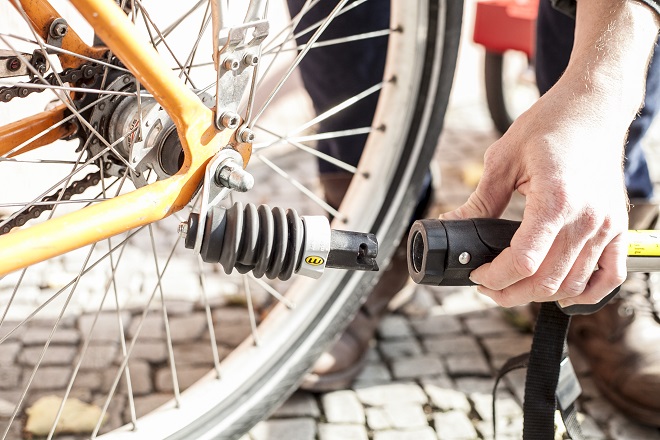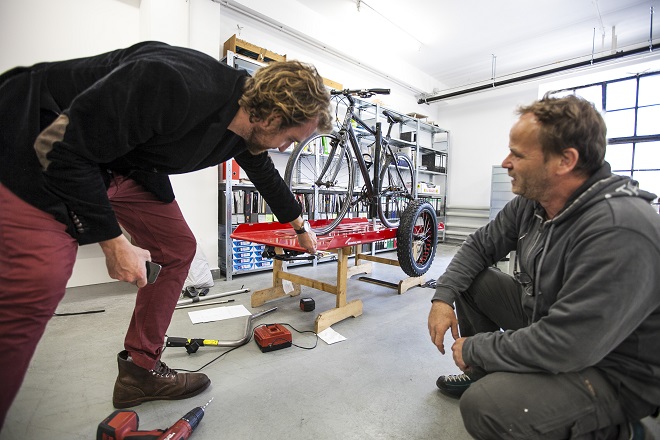Hinterher Shop Visit
It’s been a while between sessions, carry heads, but Berlin Muse continues to thrive in the Deutsch capital. After a slew of road tests and intrepid regional assignments, we’re back with a Berlin Muse foray into the essential, though oft-overlooked realm of ‘wheeled carry’.
The name ‘Hinterher’ first flicked past our radar outside a local café, necking crisp brews in the sun as a lady zoomed past on her bike, a sleek trailer lugging her kit stylishly behind her. In and of itself, this was nothing unusual: Berlin is, after all, a bike city, and by virtue of that, a city of veritable wheeled carry. The boroughs are spread, and there’s much kit to lug – how else to cart your groceries and crate of delicious Deutsch beer back to your apartment without a sweat? Your summer grill to the local abandoned airport-cum-recreation park? Your kayak to the nearest nude lake? Yes folks, whether you’re in Berlin, greater Europe, or any place with cycles and sun, a bike trailer is no longer a carry luxury. It’s a life necessity.
A big problem here is that very few bike trailers meet the brief, i.e. something that functions well, packs down neatly and looks good too. Most trailers we’ve seen in Berlin are cumbersome, bulky units with limited versatility and aesthetic zeal. Which made seeing that lady riding free and easy with her spruce-looking trailer all the more intriguing. Had the brief finally been met?

Lovingly crafted in our southern backyard, ‘Hinterher’ is a Munich-based carry enterprise that specializes in high-quality bicycle trailers for cargo transportation – in their words, a sophisticated design and utility in one. On a sparkling Berlin summer morning, we decided to train seven hours south to Bavaria to check out Hinterher’s wares with our own eyes.
“‘Hinterher’ is a Munich-based carry enterprise that specializes in high-quality bicycle trailers for cargo transportation – in their words, a sophisticated design and utility in one.”

Nach München
Bavaria is another world compared to its northern compatriots. The capital Munich is about as ‘yin’ to Berlin’s ‘yang’ as you can get – plucky northerners with tongues firmly in cheek tend to cite anything south of Hamburg as ‘Northern Italy’, a tall call perhaps, though with a shade of truth in Munich’s case.
Raining and grey as our train pulls in to the Hauptbahnhof, the spired Altstadt is shrouded in chill. Well-dressed, Milan-savvy locals in blazers and collars roam the Marienplatz, the archetypal south German scents of pork knuckle and weißwurst just streets away.
“A big problem here is that very few bike trailers meet the brief, i.e. something that functions well, packs down neatly and looks good too.”
A 40-minute trundle south of the centre takes us to a more industrial scene. Through the gates off a rear service road, in the hold of a large warehouse, we find refuge from the chill air at Hinterher HQ.
We’re met by Peter Hornung-Sohner, Hinterher’s head honcho, in comfy work-mode in a hoodie and sweat pants. “This is where the magic happens,” he says, “—and also the work,” grinning with a friendly wince. It’s an orderly space – one of the neatest we’ve come across – and colourful too, the full spectrum of Hinterher trailer hues on show, awaiting construction across the side wall.


In Deutsch, the word ‘Hinterher’ essentially means ‘to pull something behind you’, a moniker that wasn’t without its early critics. “My wife came up with (the name),” Peter tells us. “The professional advertising people said ‘no, never – hinterher: behind something – it’s negative’. But on the market, it’s very well accepted. Here, it means: ‘come, behind me; come with me’.” Like everything else about his brand, it works well.

Two main styles define Hinterher: the Hmax, and the Hmini, both built with a 4mm thick aluminium chassis, a lightweight though extremely robust design. There are 10 different colours to choose from, including Cadillac pink, khaki, and classic racing red: eye-catching without being ostentatious. Peter’s design ingenuity affords an incredibly simple mechanism: strap a tow hitch to your bike’s back wheel, click two side trailer wheels into place via ball-locking axles, connect the trailer tray to a tough aluminium towing rod, and start loading.

“Two main styles define Hinterher: the Hmax, and the Hmini, both built with a 4mm thick aluminium chassis, a lightweight though extremely robust design.”

In this cosy Munich assembly HQ, Peter and colleague David produce, pack, and mount every Hinterher order as it comes in. Two more staffers work the back-end, and a one-day-a-week industrial designer helps refine, polish and perfect Peter’s designs.

Assembling the trailer is almost as simple as setting one up. “It’s like playing Lego,” says Peter. “You take these parts, those ones, those ones – all these things are made with one screw, so you need only one tool. And then, everything’s finished within…(querying David)… Vielen brauchst dir? – Zehn minuten fur ein?” “Acht,” says David without pause – eight minutes for a full assembly (in other words: maximum simplicity).
“Assembling the trailer is almost as simple as setting one up.”

As a result of this, everything fits – perfectly. “It’s really hard work to make things so simple,” says Peter, pointing out the roll-screw mechanism in the hitch that took over a year to devise. “The fine details are very, very complicated – you don’t always see them, but they’re there.”

For Hinterher, the finer details are everything. Each piece in the trailer’s design is specially tailored and perfected to serve the whole concept. That’s essentially what makes the trailer so unique: they are a total work, reliant on the sum of their custom-conceived parts, not cobbled together from generic, pre-existing bits. Even better, each piece is designed and made locally, with only the wheels coming from nearby Italy.
“For Hinterher, the finer details are everything. Each piece in the trailer’s design is specially tailored and perfected to serve the whole concept.”

You could say that Hinterher is what happens when problem meets solution, via the mind of a professional Bavarian designer with a penchant for aesthetics and functionality. Stepping away from a 20-year career in architecture, Peter knew straight away his trailers would fill a void in the marketplace. What was less clear was just how fast they’d take off – and how quickly they’d evolve.

“In the beginning of 2012, I had a small production of furniture. I decided to buy a trailer for our own workshop. I didn’t find a trailer that could do what I needed, so I started on it, designed a prototype, and we sold them immediately. Within one year we made five series of prototypes, and the fifth series was almost like that (the current design). The whole concept grew up so fast.”

A core part of Hinterher’s concept (and speedy success) comes from the fact that they stay a manageable size, and engage with their clientele without obstruction. “We sell directly to our customers and our dealers, but we don’t have the stuff in between – no distributors – so we get a lot of input directly from the customers and we can improve things really fast.”
“A core part of Hinterher’s concept (and speedy success) comes from the fact that they stay a manageable size, and engage with their clientele without obstruction.”

Feedback from clients, as well as bespoke projects that demand innovative solutions, continues to drive Peter’s designs. “We had a Korean guy who walked with one of our big trailers through the Kalahari Desert, with 80 litres of water,” Peter smiles. He points to another: “this one is a ‘surf and SUP’; you can put long boards and surfboards on it” – perfect, I suggest, for wheeling across the nearby park to the manmade wave at Munich’s Eisbach (something he often does in his downtime).
“Feedback from clients, as well as bespoke projects that demand innovative solutions, continues to drive Peter’s designs.”
More than all this, the most crucial ingredient in the brand’s success seems to derive from the boss’s unabashed passion for his newfound life trajectory.
“After 20 years of making furniture, it’s very nice to change completely. A lot of energy that comes with such a project – the courage and everything. You have to invest sleep, energy, your stability – you have to let it all go, in the beginning of the first three or so years, but the energy comes back and the happiness, it keeps feeding. It gives really a great perspective.”

It’s difficult not to be enthusiastic about Hinterher’s setup: the ethic, the vision, the painstaking commitment to sound functionality and aesthetics. It’s everything you want to admire in a carry enterprise. They’re doing their thing, doing it right, and sustainably so – in every possible facet.
“It’s difficult not to be enthusiastic about Hinterher’s setup: the ethic, the vision, the painstaking commitment to sound functionality and aesthetics.”
Time flies chatting with Peter. Soon we make tracks, returning back to our hotel in central Munich, proudly wheeling our very own bright red Hmini in preparation for an ultimate test in the intrepid streets of hometown Berlin.
*Photography by Honor Kennedy





 Carry Awards
Carry Awards Insights
Insights Liking
Liking Projects
Projects Interviews
Interviews













